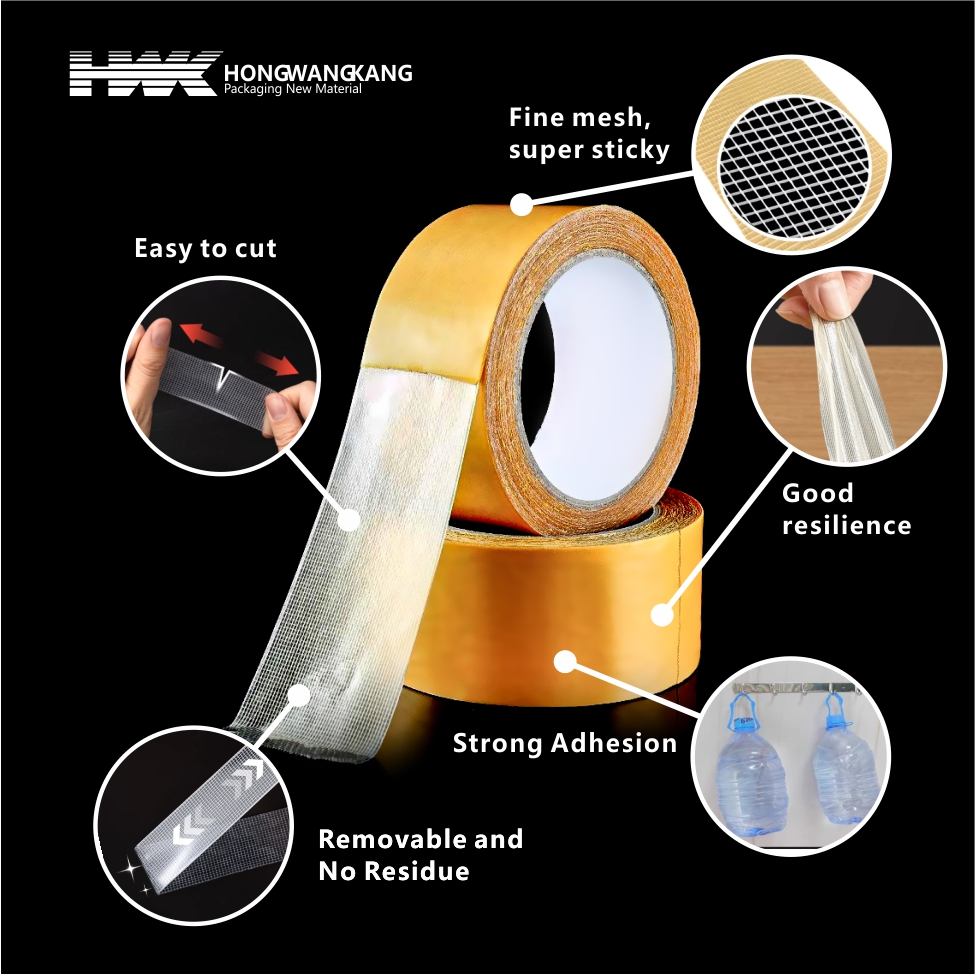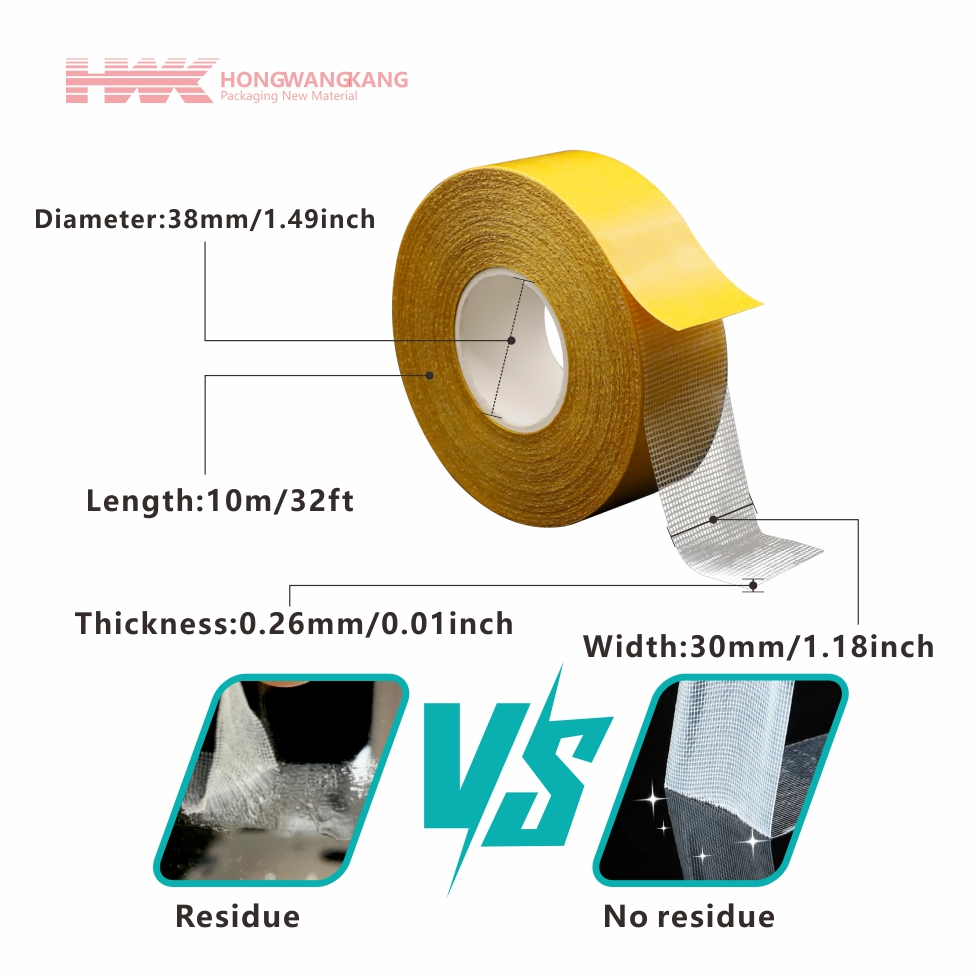Использование двусторонней тканевой ленты стало преобладающим промышленным стандартом в ряде текстильных изделий благодаря ее превосходной способности соединять различные текстильные поверхности. Будь то в мире моды или в домашнем дизайне, это решение сочетает в себе высокопроизводительные клеевые материалы, которые также обеспечивают аккуратную и обтекаемую альтернативу традиционным швейным процессам. В данной статье рассматривается процесс, с помощью которого тканевая лента способствует устойчивому признанию, и основное внимание уделяется ключевым переменным — толщине клеевого слоя и устойчивости к температуре.

Влияние толщины клеевого слоя на прочность соединения двусторонней тканевой ленты
Сцепляющие свойства двусторонней тканевой ленты зависят от толщины клеевого слоя. В большинстве случаев более толстые клеи обеспечивают лучшее сцепление и покрытие соединения, особенно на шероховатых или неровных поверхностях. Это особенно важно при склеивании тканей, поскольку ткани склонны к таким особенностям, как ворс, переплетение и неровности поверхности, которые могут препятствовать хорошему соединению.
Толщина клея позволяет ленте плотнее прилегать к текстильной поверхности, компенсируя её неровности, что увеличивает площадь контакта и обеспечивает лучшее сцепление. Такая увеличенная площадь контакта необходима, потому что гладкие ткани не могут эффективно взаимодействовать с выраженным рисунком или текстурой, например, с вельветом или жаккардом, где различия на поверхности могут препятствовать склеиванию.
Кроме того, более вязкие клеи позволяют ленте заполнять микроскопические щели в тканевой структуре, что обеспечивает герметизацию обеих поверхностей и увеличивает степень сцепления. Толщина клея также играет важную роль, поскольку минимизирует напряжения в линии склеивания и предотвращает разрушение соединения при динамических или высоко нагруженных применениях. Это особенно критично в случаях, когда лента применяется при производстве одежды, где требуется гибкость и даже прочность, чтобы преодолеть износ и деформации, характерные для использования одежды.
Однако следует учитывать необходимость регулирования толщины клея в зависимости от ткани и предполагаемого использования. Более теплые клеи, хотя и обеспечивают более прочное соединение, могут оставлять следы клея или влиять на растяжимость ткани, особенно при использовании легких тканей. Таким образом, толщина используемого клея играет ключевую роль в обеспечении эффективности и результативности процесса склеивания, а также сохранении эстетических и функциональных характеристик текстиля.
Почему устойчивость к температуре важна для многоразовой двусторонней липкой ленты на тканях
Температурная устойчивость — это относительно не учитываемый, но важный параметр эффективности двусторонней липкой ленты для тканей, особенно в случае многоразового применения. Текстиль и ткани часто подвергаются различным температурам в процессе использования, ухода или стирки. Таким образом, лента должна обладать клеевым составом, сохраняющим стабильность и прочность соединения в широком диапазоне температур, чтобы обеспечить долговечность и возможность повторного использования.
Клеевые составы могут нарушаться при изменении температуры, что может привести к разрушению соединения или его ослаблению. В холодных условиях определенные клеевые составы могут становиться хрупкими и непригодными для использования, а соединение может разорваться или отвалиться. С другой стороны, высокие температуры также могут привести к тому, что клеевые составы размягчатся и потеряют свою фиксирующую способность, оставляя липкий беспорядок или полностью отсоединяя склеенные материалы.
В случае с многоразовым двусторонним тканевым скотчем необходимо использовать клеевые составы, обладающие высокой вязкостью и способностью к адгезии даже при колебаниях температуры. Благодаря таким характеристикам, ленты могут быть удалены и установлены повторно несколько раз без потери своих эксплуатационных свойств. Эта гибкость очень важна при использовании в ремонте, подгонке одежды и временном креплении тканей, где требуется долговечность, обратимость и прочность.
Кроме того, термостойкий клей способен предотвращать эрозию клеевого слоя при очистке изделий с применением тепла (глажка или стирка в машине). Долговечность продукции, допускающей многократное использование, достигается за счет устойчивости скотча к таким условиям, что позволяет сохранять целостность ткани и обеспечивать ее презентабельный внешний вид и тактильные ощущения.
В заключение, толщина клеевого слоя и устойчивость к температурным воздействиям играют ключевую роль в эффективности и высоком уровне действия двусторонней тканевой ленты на тканевых поверхностях. Учет этих параметров позволит производителям предлагать продукцию, которая обеспечивает не только хорошее начальное сцепление, но и стабильные эксплуатационные характеристики со временем и в изменяющихся условиях. В промышленных условиях и при самостоятельном изготовлении изделий эти характеристики крайне важны для выбора наиболее подходящей двусторонней тканевой ленты, чтобы обеспечить наилучшее и долговременное соединение.
 EN
EN
 AR
AR
 CS
CS
 DA
DA
 NL
NL
 FI
FI
 FR
FR
 DE
DE
 EL
EL
 HI
HI
 IT
IT
 JA
JA
 KO
KO
 PL
PL
 PT
PT
 RO
RO
 RU
RU
 ES
ES
 TL
TL
 IW
IW
 ID
ID
 SR
SR
 UK
UK
 VI
VI
 HU
HU
 TH
TH
 TR
TR
 FA
FA
 AF
AF
 MS
MS
 GA
GA
 BE
BE
 IS
IS
 HY
HY
 BN
BN
 LA
LA
 MN
MN
 SO
SO
 MY
MY
 KK
KK

